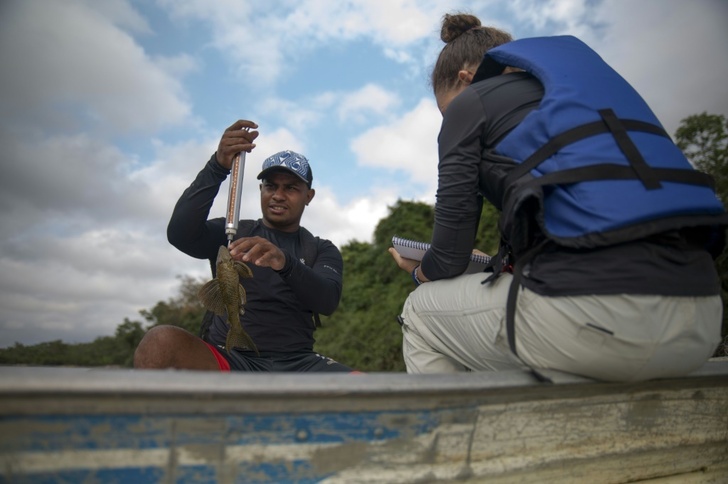Holding a dead fish, Junior Pereira looks grimly at a puddle that used to be part of Brazil's Xingu river, a mighty Amazon tributary that has been desiccated here by the massive Belo Monte hydroelectric dam.
Pereira, a member of the Pupekuri Indigenous group, chokes up talking about the impact of Belo Monte, the world's fourth-biggest hydroelectric complex, which locals say is killing one of the most biodiverse regions on Earth and forcing them to abandon their way of life.

He gazes at the once-flooded landscape, which Belo Monte's water diversion has made a patchwork of puddles dotted with stranded fish.
"We've lost our river," he says.
"Now we have to buy food in the city."
- 'Like a permanent drought' -
Stretching nearly 2,000 kilometers (1,250 miles), the Xingu ebbs and flows with the rainy season, creating vast "igapos," or flooded forests, that are crucial to huge numbers of species.
They are also crucial to an estimated 25,000 Indigenous people and others who live along the river.

Built for an estimated 40 billion reais ($7.5 billion) and inaugurated in 2016, the dam diverts up to 80 percent of the river's water, which scientists, environmentalists and residents say is disastrous for this unique ecosystem.

That is devastating fish and turtle populations whose feeding and reproduction cycles depend on the igapos, he says.
Sitting by the Xingu's breathtaking Jericoa waterfalls, which the Juruna people consider sacred, Indigenous leader Giliarde Juruna describes the situation as a clash of worldviews.

"They think they're doing good with this project, but they're destroying nature and hurting people, including themselves."
- Lula under scrutiny -
Proposed in the 1970s, Belo Monte was authorized under ex-president Luiz Inacio Lula da Silva (2003-2010) -- who just won a new term in Brazil's October elections.

Touted as a clean-energy source and engine of economic development, Belo Monte has not exactly lived up to expectations.

A recent study meanwhile found its operations tripled the region's greenhouse gas emissions -- mainly methane released by decomposing forest that was killed by the flooding of the dam reservoir.
- A new plan -
In 2015, researchers from the Socio-Environmental Institute (ISA) conservation group teamed up with the Juruna to document the devastation.

Researchers say the plan is a relatively small tweak to the dam's current water usage, adapting it to the natural flood cycles.
Brazil's environmental regulator is due to rule soon whether to order Norte Energia to adopt it.
The company declined to comment on the proposal, saying in a statement to AFP that it instead "recognizes the plan established in the plant's environmental licensing."
The decision is vital, says biologist Camila Ribas of the federal government's National Institute for Amazon Research.

"These are incredibly intricate, interlinked systems. If Belo Monte and other hydroelectric projects disrupt them too much, it could spell the end of the Amazon."
str-jhb/fb
© Agence France-Presse
Your content is great. However, if any of the content contained herein violates any rights of yours, including those of copyright, please contact us immediately by e-mail at media[@]kissrpr.com.
Source: Story.KISSPR.com

